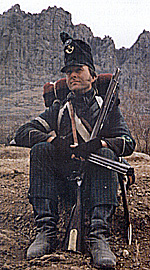Battle of Vera 1813
"Please God,
I Will Keep the Bridge"
Introduction:
August 31st - September 1st, 1813
by Rifleman Moore
| |
Marshal Jean de Dieu Soult, Duke of Dalmatia, began a nine-day offensive ending in July 1813. The attacks failed to achieve their objective, the relief of the fortress town of Pamplona or inducing Wellington to order troops away from San Sebastian, both towns in Spain still garrisoned by French soldiers but besieged or surrounded.
Whilst the losses in the Allied forces were heavy, the French ended up finally defeated at Sorauren with similar losses but a far greater detraction in disorganisation and a terrific drop in morale.
It was because of these losses and the political situation surrounding an Armistice between Bonaparte and the Allies in Northern Europe that no Allied pursuit took place after the French retreat back into France on August 2nd. Full consideration was then given to a reduction of both ‘frontier’ fortresses : San Sebastian would be fired on by new British siege weapons arriving by convoy and then stormed, with the already hungry Pamplona surrounded by Spanish troops starved into submission.
The siege guns opened up on the walls of San Sebastian on August 26th under the able direction of Alexander Dickson. This coastal fortress was not completely surrounded, and the French were able to bring in fresh supplies and reinforcements by sea throughout the siege. Despite earlier failures, by August 31st a time and a date was set for the storming of two breaches.
Wellington received intelligence towards the end of August that Soult was planning a second counter-offensive, this time towards San Sebastian. At dawn on August 31st, two French columns moved south and crossed the Bidassoa River ; the first at Behobie near the coast and the second at Vera, further inland.
At Behobie, the bridge over the river had been destroyed, but five good fords could be used. Three Divisions under a morning fog and covering fire from their artillery crossed, preceded by skirmishers. A mile further south, Wellington had placed Spanish troops on the San Marcial hill to meet the French attacks. Soult’s troops attacked piecemeal up the extremely steep hillsides towards the crest and hermitage without prudent cover from their artillery, not yet up ; as a result they were badly mauled and in the ensuing rout the weight of the fleeing soldiers - fearing a vengeful Spanish pursuit with no prisoners taken - sank one of the recently
erected pontoon bridges over the river behind them.
The second attack eight miles inland from Behobie beyond the Great Gorge of the Bidassoa advanced slowly through the same fog towards Vera, four Divisions under Clausel. By 7am the fog had cleared and the British and Portuguese soldiers on the Santa Barbera heights south of the village could clearly see French voltigeurs covering three Divisions moving towards the fords over the River Bidassoa downstream to the west of them, with another voltigeur force and a fourth Division obviously making for the bridge over the River Bidassoa at Vera. French artillery opened fire on the village, forcing a picket of the 2/95th Rifles beyond the village
to the north to scurry back towards Vera and the rest of the 2/95th, then between the village and the lower slopes of the hills as the reinforced voltigeurs moved forwards under cover of the bombardment.
As the French artillery at the fords opened fire some time later, their projectiles fell at first into the river amongst the French soldiers then crossing, raising a great cheer of derision from the watching Allies. The French Divisions crossing at the fords became involved in a ‘tedious’ day-long firefight with two Brigades of troops from the 4th and 7th Divisions, finally disappearing from view into the remoteness of the Pena de Haya, a four-peaked mountain range stretching off north-west towards Irun.
Wellington had correctly deduced Soult’s plan and ordered the 7th Division soldiers then posted at the Maya Pass to move forwards in a feint attack to disrupt the French plans. He also ordered troops to the east and south-east of Vera to head for the village.
More Battle of Vera 1813
|
 ‘Rifleman Moore’ tells us a fourth story in his series of small but heroic actions of the 95th Rifles during the Peninsular War.
‘Rifleman Moore’ tells us a fourth story in his series of small but heroic actions of the 95th Rifles during the Peninsular War.